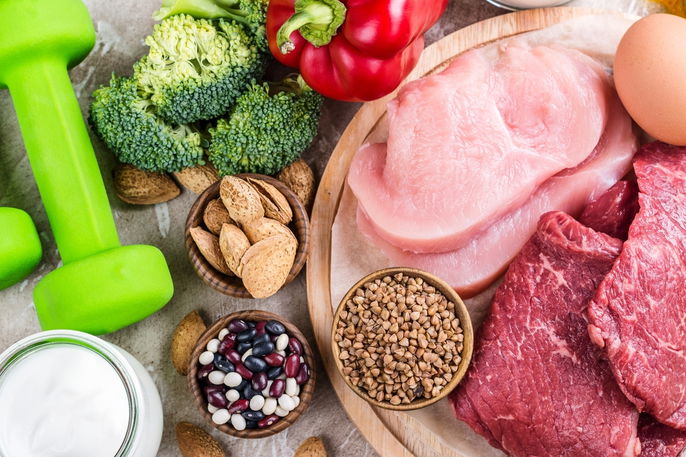A body recomposition diet should be high in protein, healthy fats, and whole grains and low in simple sugars and saturated fats. It should be accompanied by regular physical activity, sufficient fluid intake, and adequate rest.
It is important to engage in daily exercise such as weight training or CrossFit to help you gain muscle mass. 30 minutes of aerobic exercise, such as walking and cycling, can help stimulate fat loss without diminishing muscle mass.
Losing body fat requires burning more calories than you take in. However, consuming too few calories during the day can result in loss of muscle mass and have a negative effect on your physical fitness. For this reason, it is recommended to meet with a registered dietitian who can help you develop an adequate diet plan based on your own individual needs.

Guidelines and recommendations
Recommendations for following a body recomposition diet include:
1. Eating foods high in protein
Eating high protein foods at every meal is important for maintaining muscle mass. These include foods like lean red meat, fish, chicken, turkey, eggs, tofu, cheese, and fat free yogurt.
The ideal amount of protein to consume to build muscle mass will depend on the intensity of your workouts as well as your weight, age, and sex. Recommended protein intake is 0.8 to 2 g per kg of body weight per day.
2. Prioritizing whole grains
Prioritizing whole grains like quinoa, oats, whole grain bread, brown rice, and whole wheat pasta is important for fat loss. Whole grains are high in fiber, which helps control hunger and decrease the amount of food consumed during the day.
Whole grains can also help build muscle because they are a good source of carbohydrates, a nutrient that helps to restore energy immediately following physical exercise.
3. Eating fruits and vegetables
Daily intake of fruits and vegetables, such as oranges, apples, papaya, bananas, spinach, carrots, eggplant, and zucchini, helps with fat loss due to the high fiber content that prolongs satiety (feeling of fullness) throughout the day.
Fruits and vegetables are also a good source of carbohydrates, vitamins, and minerals that are important for building muscle.
4. Choosing healthy fats
Healthy fats like peanuts, cashews, almonds, olive oil, sardines, and coconut help build muscle because fat is fundamental in the production of hormones that stimulate the formation of muscle cells.
Healthy fats also provide energy to the body, improving exercise performance and helping with muscle building and fat loss.
5. Drinking lots of water
Drinking lots of water during the day (2 liters or eight-to-ten 8 oz glasses) helps with fat loss by controlling appetite and decreasing the number of calories consumed during the day.
Drinking lots of water also helps build muscle because water helps with muscle contraction and is essential for the storage and release of muscle glycogen, which helps provide energy during physical exercise.
Also recommended: 10 Benefits of Drinking Water (with Healthy Recipes) tuasaude.com/en/benefits-of-drinking-waterFoods to avoid
In order to build muscle and lose fat, it is important to avoid the following foods:
- Foods high in sugar, like ice cream, soda, cookies, and cakes;
- High fat meats, such as linguiça, rump steak, ribs, and skirt steak;
- Smoked and cured meats, such as sausage, prosciutto, mortadella, and salami;
- Refined carbs, like white bread, pasta, and white rice;
- Shelf-stable condiments, like mayonnaise, ketchup, ready-made sauces, and seasonings that come in powders or cubes.
It is also recommended to avoid consuming alcoholic beverages, like beer and wine, as these beverages can lower metabolism and decrease muscle cell formation in addition to reducing the body's ability to burn fat.
Meal plan
The following table is an example of a 3-day meal plan that can be included as part of a body recomposition diet:
The foods and portions included in this meal plan may need to be adjusted based on age, weight, height, and level of physical activity. For this reason, it is important to consult a registered dietitian who can evaluate your diet and develop an individualized nutrition plan based on your unique needs.
Is it necessary to take supplements?
Following an adequate meal plan along with regular physical exercise is usually enough to burn fat and gain muscle. In some cases, dietary supplements can be used to help build muscle mass and get the most out of your workouts, however these should only be taken as directed by a doctor or registered dietitian.
Whey protein, from cow's milk, is one of the most commonly used supplements. It can help increase strength and physical performance. Amino acid supplements are also available that can help prevent muscle breakdown during intense physical exercise.
See best supplements for muscle growth.
Tips and strategies
Other strategies to help with fat loss and muscle building include:
- Practicing strength training exercises, such as weightlifting, calisthenics, or CrossFit, as well as aerobic exercises like dance, running, and rollerblading;
- Getting 7 to 9 hours of sleep a night, as sleep helps balance the production of ghrelin and leptin, hormones responsible for regulating hunger and satiety that are important for weight loss;
- Chewing your food slowly, which helps prolong a meal and gives your brain time to realize that your stomach is full. This can help prevent overeating and result in fat loss.
The addition of nutritional supplements such as whey protein, creatine, and BCAAs can also help build muscle. Read about other muscle building foods.






























